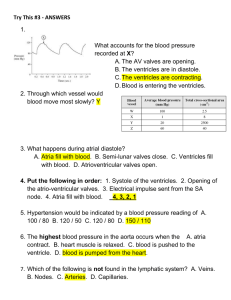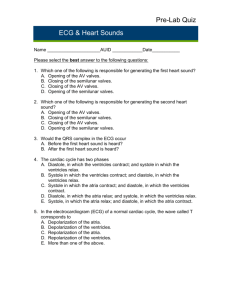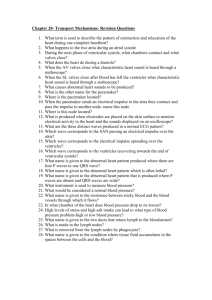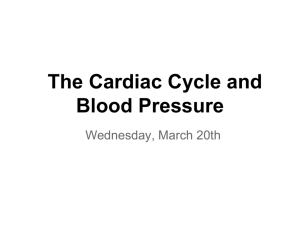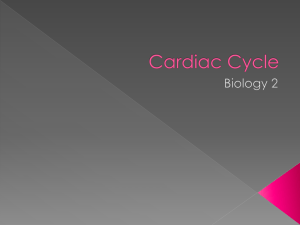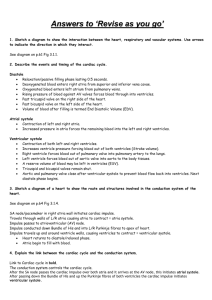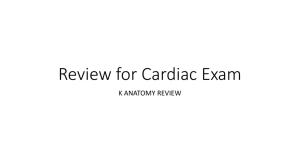Heart Anatomy & Physiology Exam Questions
advertisement
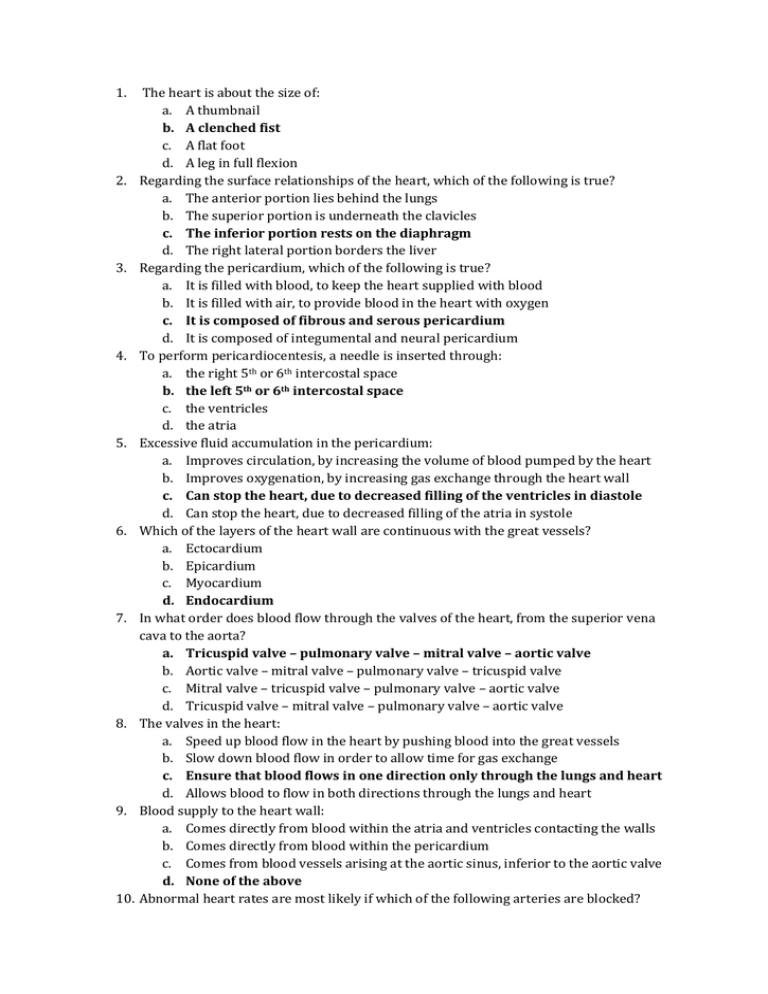
1. 2. 3. 4. 5. 6. 7. 8. 9. 10. The heart is about the size of: a. A thumbnail b. A clenched fist c. A flat foot d. A leg in full flexion Regarding the surface relationships of the heart, which of the following is true? a. The anterior portion lies behind the lungs b. The superior portion is underneath the clavicles c. The inferior portion rests on the diaphragm d. The right lateral portion borders the liver Regarding the pericardium, which of the following is true? a. It is filled with blood, to keep the heart supplied with blood b. It is filled with air, to provide blood in the heart with oxygen c. It is composed of fibrous and serous pericardium d. It is composed of integumental and neural pericardium To perform pericardiocentesis, a needle is inserted through: a. the right 5th or 6th intercostal space b. the left 5th or 6th intercostal space c. the ventricles d. the atria Excessive fluid accumulation in the pericardium: a. Improves circulation, by increasing the volume of blood pumped by the heart b. Improves oxygenation, by increasing gas exchange through the heart wall c. Can stop the heart, due to decreased filling of the ventricles in diastole d. Can stop the heart, due to decreased filling of the atria in systole Which of the layers of the heart wall are continuous with the great vessels? a. Ectocardium b. Epicardium c. Myocardium d. Endocardium In what order does blood flow through the valves of the heart, from the superior vena cava to the aorta? a. Tricuspid valve – pulmonary valve – mitral valve – aortic valve b. Aortic valve – mitral valve – pulmonary valve – tricuspid valve c. Mitral valve – tricuspid valve – pulmonary valve – aortic valve d. Tricuspid valve – mitral valve – pulmonary valve – aortic valve The valves in the heart: a. Speed up blood flow in the heart by pushing blood into the great vessels b. Slow down blood flow in order to allow time for gas exchange c. Ensure that blood flows in one direction only through the lungs and heart d. Allows blood to flow in both directions through the lungs and heart Blood supply to the heart wall: a. Comes directly from blood within the atria and ventricles contacting the walls b. Comes directly from blood within the pericardium c. Comes from blood vessels arising at the aortic sinus, inferior to the aortic valve d. None of the above Abnormal heart rates are most likely if which of the following arteries are blocked? 11. 12. 13. 14. 15. 16. 17. 18. a. The right coronary artery, because it supplies the SA and AV nodes b. The circumflex artery, because it supplies both the left atrium and left ventricle c. The left anterior descending artery, because it supplies both the left and right ventricles d. The central coronary artery, because it supplies the vagus nerve If the foramen ovale does not close, blood will mix between: a. the right atrium and left atrium b. the right ventricle and left ventricle c. the pulmonary artery and the aorta d. the pulmonary veins and the aorta Regarding heart rate and cardiac filling, which of the following is false? a. Normally, systole takes up 40% of the cardiac cycle; diastole, 60% b. As heart rate increases, both systolic and diastolic intervals shorten c. Diastole shortens less than systole, so the heart spends less time in systole than diastole d. At very fast heart rates, there is less time for the heart to fill, so it pumps less blood Atrial contraction: a. Provides 20% of blood to the ventricle b. Provides 80% of blood to the ventricle c. Requires conscious flexion of cardiac muscle d. Is essential to providing normal cardiac output at rest The QRS complex on an EKG corresponds to: a. The spread of depolarisation through the atria prior to atrial systole b. The spread of depolarisation through the ventricles prior to ventricular systole c. The repolarisation of ventricles just before the end of contraction d. None of the above S1 corresponds to which of the following events: a. Atrial systole at end of diastole, due to inrush of blood into ventricles b. Ventricular filling during diastasis c. Closing of AV valves at beginning of systole d. Snap closing of semilunar valves at end of systole S2 corresponds to which of the following events: a. Atrial systole at end of diastole, due to inrush of blood into ventricles b. Ventricular filling during diastasis c. Closing of AV valves at beginning of systole d. Snap closing of semilunar valves at end of systole S3 corresponds to which of the following events: a. Atrial systole at end of diastole, due to inrush of blood into ventricles b. Ventricular filling during diastasis c. Closing of AV valves at beginning of systole d. Snap closing of semilunar valves at end of systole S4 corresponds to which of the following events: a. Atrial systole at end of diastole, due to inrush of blood into ventricles b. Ventricular filling during diastasis c. Closing of AV valves at beginning of systole d. Snap closing of semilunar valves at end of systole 19. Which of the following best describes stroke volume? a. Stroke volume = the volume of blood at start of diastole minus the volume at start of systole b. Stroke volume = the volume of blood at end of diastole minus the volume at end of systole c. Stroke volume = the volume of blood in the ventricles minus the volume in the atria d. Stroke volume = the volume of blood in the ventricles plus the volume in the atria 20. Regarding cardiac output and afterload, which of the following is true? a. If afterload is greater than 160mmHg, cardiac output increases because more blood volume is returning to the heart, improving flow b. If afterload is greater than 160mmHg, cardiac output decreases because the heart is pumping against more resistance c. Regardless of the pressure, afterload always reduces stroke volume d. There is no relationship between afterload pressure and stroke volume

